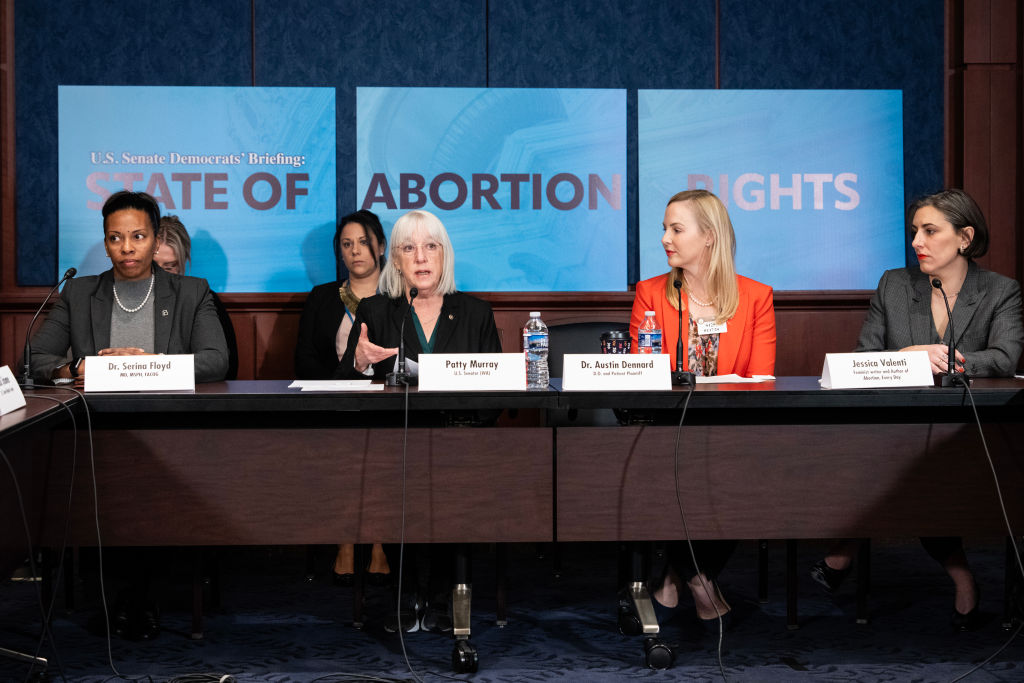A panel of Senate Democrats and activists discussed abortion rights, state-level bans, anti-abortion lawmakers’ plans, and the need for the Women’s Protection Act to restore abortion rights nationwide.

“This cruelty that treats American women as less-than-human is all by design.”
—Jessica Valenti
The Current U.S. Abortion Landscape
A year and a half since the U.S. Supreme Court struck down Roe, abortion is currently banned in 14 states and highly restricted in an additional 10, and the average American lives 86 miles from an abortion provider. This leaves many pregnant people with the complex task of traveling across state lines—spending substantial amounts of money and time—to receive essential medical care.
When a routine ultrasound diagnosed her fetus with anencephaly—a defect in which a fetus develops without parts of the brain and skull, with no chance of survival—Dr. Austin Dennard, an obstetrician, gynecologist and patient plaintiff in Zurawski v. Texas, was forced to leave her home state of Texas to receive essential abortion care. Dennard was not allowed the time and space to properly mourn her loss. Instead, she feared for her and her family’s lives.
“My mind began to spin. Where am I going to go? Who is going to take care of me? Who will take care of my children when I’m gone?” said Dennard.
These bans have stolen so much joy.
Dr. Austin Dennard
Ahead of the 51st anniversary of Roe v. Wade, Sen. Patty Murray (D-Wash.) hosted a briefing last Wednesday on the tragic state of abortion in the U.S. Panelists, including Dennard, outlined how the lack of access to reproductive care in the U.S. has caused a national health crisis, prompting questions as to how the country might move forward in a post-Roe world.
Can Doctors Perform Life-Saving Abortions?
In an attempt to protect abortion access after the Dobbs decision, the Biden administration issued a presidential memo in June 2022 that the Emergency Medical Treatment and Active Labor Act (EMTALA) applies in emergency medical cases where abortion is necessary to stabilize a patient.
But subsequent court rulings have weakened the protections of EMTALA, pending a Supreme Court hearing in April—making it impossible, for now, for the federal government to enforce EMTALA in states with abortion bans like Texas and Idaho, even when doctors deem that women abortions to save their lives.
“[Doctors] are being made to ignore and are being forced to delay life-saving medical care in direct opposition to the oath to which we are sworn,” said Dr. Serina Floyd, chief medical officer for Planned Parenthood of Metropolitan Washington, D.C., at the Wednesday briefing.
The Potential Tragedy of a National Abortion Ban
Just last week, ahead of Friday’s March for Life, the Republican-led U.S. House passed two new anti-abortion bills (both with only Republican support): The Pregnant Students’ Rights Act, which purports to offer resources to pregnant students, but only to those who carry the pregnancy to term; and the Supporting Pregnant and Parenting Women and Families Act, which seeks to divert federal funds toward anti-abortion crisis pregnancy centers.
Both proposals are likely to die in the Democratic-controlled Senate—for now. But the Biden administration released a statement last week stressing anti-abortion activists’ plan to ban abortion with or without congressional backing, should Republicans take back the White House: They plan on utilizing the Comstock Act, which prohibits sending “obscene” information or materials by mail. When applied to abortion restrictions, the law would ban not only the shipment of abortion drugs, but any medical equipment doctors might use in an abortion.
Should the anti-abortion movement be successful in stopping the distribution of mifepristone, the abortion pill, the effects would be similar to that of a national ban, warned Jessica Valenti, feminist writer and author of the Abortion Every Day newsletter.
“I think what’s so distressing to me, in addition to the possibility of a national ban, is that Republicans don’t need to pass a national ban in order to have the kind of impact that a national ban would have,” said Valenti at the briefing.
The Supreme Court is also set to rule on a request by the Department of Justice and the abortion pill maker Danco Laboratories to review a Fifth Circuit Court decision drastically limiting access to mifepristone. A decision to maintain the ruling in question from the Fifth Circuit would mean that mifepristone would no longer be available by telemedicine—an increasingly important avenue for accessing abortion, particularly for people living far from abortion clinics or in states banning abortion clinics. Without telehealth services, abortion seekers will be forced to go to clinics and doctors’ offices to receive the medication, exposing them to harassment, threats and other types of violence from anti-abortion extremists, which has dramatically increased since the fall of Roe.
The Path Forward to Restore Access
The Women’s Health Protection Act (WHPA) is proposed federal legislation that would codify Roe v. Wade into law and establish the legal right to abortion in all 50 states. WHPA has been reintroduced in several congressional sessions—and in 2022, the bill saw the highest numbers of original co-sponsors ever. The U.S. House has voted to pass WHPA twice: in September 2021 and July 2022. But in the Senate, WHPA failed to secure the 60-vote threshold needed to make it to the floor for a vote, after all Senate Republicans, joined by Democratic Sen. Joe Manchin (W.Va.), prevented cloture, which would have forced a vote.
The WHPA also requires federal healthcare programs to provide abortion coverage. However, it is important that we look beyond restoring Roe, according to Valenti and Floyd.
“Roe was always the floor,” said Floyd, “and right now what this country needs to address the state of abortion care is so much more than what Roe gave us.”
In addition to the WHPA, senators and panelists at Wednesday’s briefing discussed the Freedom to Travel for Healthcare Act, which would prohibit state interference for those traveling across state lines to access reproductive healthcare. This is especially important, as Valenti mentioned, because those traveling for abortion care often have more complicated pregnancies and therefore require more complex levels of care.
In the meantime, confusion surrounding abortion care remains high, especially in young people: Seventy-three percent of respondents could not name a clinic or healthcare provider they could go to if they needed an abortion, according to new polling data from Power to Decide. People don’t know what their options are, and in many cases are afraid to ask.
What Americans are not confused about, however, is their stance on the right to safe and legal abortion. More than three out of five Americans support laws guaranteeing the right to abortion, according to a survey conducted in early January by Navigator Research. This support is sure to play a large role in the upcoming presidential elections.
“If voters are actually allowed to have a direct say, I think they will make what they believe very, very clear,” said Valenti.
Linking Abortion and the ERA
The ERA could also provide a basis for challenging state-level bans on access to abortion and other reproductive health services, since abortion bans exacerbate sex inequalities in educational, economic and political life caused by childbearing and childrearing.
In 1998, the New Mexico Supreme Court ruled that an abortion funding prohibition violated New Mexico’s Equal Rights Amendment. In a similar 1986 case, a Connecticut court struck down a law that only allowed Medicaid funding for abortion when a pregnancy endangers a woman’s life. The court ruled that choosing to fund all medically necessary procedures except for abortion is sex discrimination in violation of Connecticut’s Equal Rights Amendment.
ERA advocates have laid out a strategy for final recognition of the ERA:
- a joint congressional resolution to remove the timeline and recognize the ratification of the ERA: House Joint Resolution 25 was introduced by Rep. Ayanna Pressley (D-Mass.) and Senate Joint Resolution 4 by Sen. Ben Cardin (D-Md.) in the House and Senate, respectively. “Constitutional law scholars carefully crafted this resolution’s language, modeled on the congressional resolution recognizing the 14th Amendment, in order to prevail in any future legal challenges to the ERA,” reported Carrie Baker in Ms.
- a separate congressional resolution, called the “ERA Now” resolution, instructing the archivist to publish the ERA as the 28th Amendment: Rep. Cori Bush (D-Mo.), co-chair of the Congressional Caucus for the Equal Rights Amendment, and Sen. Kirsten Gillibrand (D-N.Y.) introduced the legislation. (The resolution is meant to work in concert with the one above.)
- a “discharge petition,” which seeks to compel the House of Representatives to vote on H.J. Res. 25 to remove the arbitrary deadline for ratification: Under House rules, if a discharge petition to compel a vote on a particular piece of legislation is signed by 218 members of the House, it must immediately be brought before the full chamber for a vote, regardless of any objections or attempts to block the legislation from being considered. Now that Pressley has filed it, the petition will remain open until it garners the necessary 218 signatures necessary to be called for a vote.
- a petition drive to show widespread support for the amendment: Public support for the ERA is around 85 percent. (Sign the petition here.)
Looking Ahead
The path forward to securing U.S. abortion rights is not well-lit, but restoration of access becomes more crucial by the day. With persistent abortion restrictions and the possibility of a national ban looming with the upcoming presidential election, Americans are left to ponder the question Valenti proposed in her opening statement: “Why would anyone want to deliberately create a world where women are forced to be ‘walking coffins’?”
Up next:
U.S. democracy is at a dangerous inflection point—from the demise of abortion rights, to a lack of pay equity and parental leave, to skyrocketing maternal mortality, and attacks on trans health. Left unchecked, these crises will lead to wider gaps in political participation and representation. For 50 years, Ms. has been forging feminist journalism—reporting, rebelling and truth-telling from the front-lines, championing the Equal Rights Amendment, and centering the stories of those most impacted. With all that’s at stake for equality, we are redoubling our commitment for the next 50 years. In turn, we need your help, Support Ms. today with a donation—any amount that is meaningful to you. For as little as $5 each month, you’ll receive the print magazine along with our e-newsletters, action alerts, and invitations to Ms. Studios events and podcasts. We are grateful for your loyalty and ferocity.





